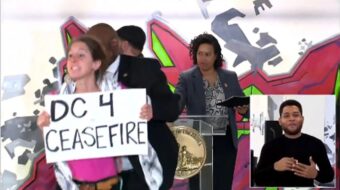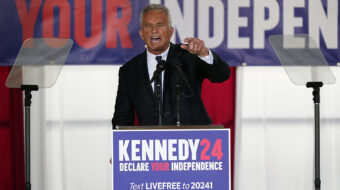
Fed-up with corporate domination of electoral politics and the two major parties, some voters resort to casting ballots for what they consider to be the lesser of two evils between Republicans and Democrats.
Instead of being an effective tactic, this approach denies the growing resistance movement a collective strategy for victory just when it needs it most, including as it goes on the offensive in 2018.
The American people face a grave threat to democracy. Donald Trump, who likely gained office in part through a domestic and international traitorous conspiracy, is an authoritarian president steeped in lies, corruption, hate, white supremacy, and misogyny. He is openly tied to the so-called “alt-right,” or rebranded fascists.
The GOP-dominated Congress is aiding and abetting Trump’s unrelenting assault on Constitutional and democratic rights and his reactionary agenda while aggravating the existential threats of climate change and thermonuclear war.
Gerrymandering, voter suppression, and immigration restrictions have one purpose: to consolidate a GOP voter base, including a fascist base, and institutionalize extreme right-wing governance for decades to come in the face of changing politics and demographics.
In this context, voting “lesser evil” unintentionally equates both major parties when in fact Republicans, backed by the most reactionary sections of Wall Street, including the fossil fuel industry and military-industrial complex, have largely driven the nation’s political agenda, bringing us to this crisis.
Voting “lesser evil” suggests the American people are helpless in this situation, lacking agency. This outlook ends up strategically disarming the resistance.
Labor unity and political independence
With a national right-to-work law in the works and the Supreme Court prepared to rule on Janus v. AFSCME, the very existence of the labor movement and collective bargaining rights are at stake.
Delegates to the October AFL-CIO convention in St. Louis deliberated over how to respond to this dire situation and build a united resistance. They expressed growing anger from declining living standards, social benefit cuts, rising racism, misogyny, and anti-immigrant hysteria and a political system dominated by the 1 percent, including both major parties.
The resolutions showed how difficult achieving unity can be when the labor movement is under severe assault and relatively small; when union households were divided between Sen. Bernie Sanders and Hillary Clinton in the 2016 Democratic primary; and when in the general election, 37 percent of union members and 43 percent of union households voted for Donald Trump, including a 52 percent majority of white union households.
The labor movement is a critical component of the Democratic Party’s electoral coalition and holds leadership positions at every level. At the 2016 Democratic National Convention, labor made up a quarter of delegates. The Sanders campaign, unions, and social justice movements won important concessions in the platform, widely considered the most progressive ever adopted by a major political party.
Labor’s continuing influence is seen in the Democratic Party’s Better Deal platform, which bars right-to-work laws, striker replacement, and employer interference in union drives, as well as the adoption of a 50-state strategy.
When it comes to political independence, the AFL-CIO has not been standing pat. The federation quit giving a blank check to the Democratic Party years ago and instead backs candidates on a case-by-case basis. It has built an independent apparatus to register, educate, and mobilize its members during election time and in between.
It established Path to Power to train union members to run for public office. Nearly 900 have been elected in New Jersey over the past 20 years and on Nov. 8 last year, 200 were elected.
These campaigns are part of a much broader resistance sparking thousands of grassroots candidates, starting with women, many who won on Election Day 2016. According to Emily’s List, over 22,000 women have approached the organization for candidate training since the 2016 election.
The same is true with environmentalists, scientists, people of color, those identifying with the Democratic Socialists of America, and more. Candidate trainings are often being done collaboratively.
Together, these campaigns are shaking up electoral politics and the Democratic Party.
Individual unions are also active in the Working Families Party (which takes advantage of more flexible electoral laws in certain states without splitting the vote), state-based electoral alliances, and Labor for Our Revolution, which continues to fight for the Sanders agenda.
In Resolution 48, AFL-CIO delegates voted to explore new directions in electoral politics, including via referendum and ballot initiatives at the state and local level and “the viability of independent and third party politics”—a concept far broader and more flexible than creating a “labor party.” In combination with alliance building, running candidates and mobilizing year around, labor intends to cover every base.
When the advocacy of “lesser evil” politics is combined with a call to create a labor party at this moment, or even for Bernie Sanders to launch an independent bid for the presidency, the electoral coalition essential to defeating the extreme right in 2018 and 2020 is threatened with splits and demobilization.
Without breaking the GOP stranglehold on federal and state government, there can be no hope of defending labor’s rights, let alone passage of employee free choice legislation and achieving democratic structural reform in the electoral arena.
Two-party system and coalition politics
The “winner-take-all” two-party system is inherently undemocratic, especially compared to a parliamentary system. For the moment, however, it is what we have. Ignoring this reality, the rising right danger, and overestimating the size of the left were key reasons the Labor Party failed to take-off the first go-around in the late 1990s and early 2000s.
The notion of supporting the “lesser evil” takes an abstract approach to both major parties, which have far different social bases in the real, concrete world. It obscures the political dynamic taking place in the Democratic Party, including the existence within it of progressive, left, and socialist activists and elected officials.
It also doesn’t take account of the presence of the African-American, Latinx, Asian, and Native American communities within the Democratic Party coalition. Not to mention the women’s, LGBTQ, environmental justice, disability, and immigrant rights movements. All these forces, without any illusions, see the Democratic Party as the electoral vehicle to advance their agendas. All play an active role inside and outside the party, shaping it to one degree or another.
This is the core of the diverse coalition led by African-American voters that delivered a historic victory for Doug Jones in the Alabama senate race December 12.
Given the danger posed by the extreme right, this coalition is growing within the Democratic Party at the same time that it is becoming more independent of the party. When the time is ripe, it will form the basis of a new people’s party (or force the exodus of corporate forces from the Democratic Party), one far more inclusive than simply a labor party formation. But that is unlikely to occur until the right-wing stranglehold is decisively broken.
“Lesser evil” concepts downplay the need to build alliances with every conceivable force against the extreme right, including taking advantage of splits among the corporate ruling class. This implies a momentary alliance with sections of capital that comprise the Democratic establishment that are at war with the right wing. These sections are unreliable, wavering, and prone to capitulation, but given the right danger, they are necessary allies at this moment.
The complex relationship is one of cooperation but also one of contention, conflict, and contradiction, with each force seeking to impose its will.
Motion and change
The correlation of class and social forces in the Democratic Party is constantly changing under the impact of events. Today’s Democratic Party is a different one than what we had when Bill Clinton and the Democratic Leadership Council sought to make it even more pro-corporate in the face of the rising neoliberalism and a Newt Gingrich-led Republican House majority in the 1990s.
Nor is it the same party as 2008 when Barack Obama was elected and Democrats gained control of Congress. Although Democrats had big legislative accomplishments in the depths of the Great Recession, they didn’t act on labor law reform, comprehensive immigration reform, and other top progressive priorities. They made big concessions to Wall Street and produced the Trans-Pacific Partnership “free trade” pact and similar measures.
But this is only part of the story. President Obama and the Democratic Congress faced total and unrelenting obstruction by the GOP, forces like the Koch brothers, and the entire right-wing media/mobilizing apparatus—while the forces that elected them largely went home. The section of “Blue Dog” Democrats that then still constituted a formidable force in Congress couldn’t be counted on to support labor’s agenda.
After the 2010 elections, Democrats lost both their super Senate majority and the House majority. The political balance shifted, and Democrats faced new limitations.
The 2018 and 2020 elections offer an opportunity to shift the balance again, this time in a more favorable direction. The greatest unity and mobilization possible is needed to defeat the grave danger posed by Trump, the GOP, and right-wing extremism. All future social change hinges on the outcome of this epic battle.

MOST POPULAR TODAY

Zionist organizations leading campaign to stop ceasefire resolutions in D.C. area


High Court essentially bans demonstrations, freedom of assembly in Deep South

Afghanistan’s socialist years: The promising future killed off by U.S. imperialism

Communist Karol Cariola elected president of Chile’s legislature






Comments